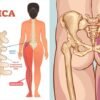
It is important to understand that sciatica symptoms are not a medical condition in and of themselves. Sciatica symptoms related to back pain are formerly known as lumbar radiculopathy. Lumbar meaning low back and radicular meaning radiating pain and that radiating pain is experienced through the sciatic nerve, which runs from the lower back to the foot. Sciatica is a lot easier to say than lumbar radiculopathy.
For most people experiencing sciatica symptoms, it is due to lumbar radiculopathy. Other medical conditions affect the sciatic nerve and produce sciatica symptoms like lumbar radiculopathy. It is important to get an accurate diagnosis of what is causing your symptoms and not to assume it is classic sciatica associated with back pain. In our blog ‘Is your leg pain sciatica or something else’ we cover a few conditions that can affect the sciatic nerve.
In this blog, we will run through the classic sciatica symptoms. If you have ever experienced sciatica no doubt you will know them well. You can experience some or all. Sometimes at the same time or at different times.
Severe Sciatica Symptoms
Pain
Number one we have pain. Where the pain is experienced and to what degree is variable. The pain sensation can be aching, burning, or stinging. The pain can follow a specific path such as down the back of the leg, or sometimes it can be in one specific area such as the buttock or calf. In terms of pain, this can be from mild discomfort to disabling pain where the smallest movement can bring on excruciating pain. Many people have testified that it is the worst pain they have ever experienced. This intense pain is usually felt in the acute (early) stage of sciatica; thankfully, it calms down within a few weeks for most people. No pain in the back does not mean that the lower back is not the root cause.
Cramping
A cramping pain feels like the muscles in the affected leg are contracting of their own accord. Sometimes muscle spasms are experienced, and the muscles feel very tight.
Milder Sciatica Symptoms
The following milder symptoms are interesting in that they can be useful warning signs or signs that the road to recovery has started.
Numbness and pins and needles can be experienced in everyday life. We have all experienced falling asleep or sitting in a funny position for too long which has resulted in a leg or arm that has gone to ‘sleep’. The result is an arm or leg that we struggle to move, we have a loss of feeling and we get pins and needles as it ‘wakes up’. The cause of these symptoms is reduced blood flow and or too much prolonged pressure on the nerves.
Some people experience these symptoms before a major acute painful episode of sciatica. It was a warning sign that was not recognized. If by chance you are reading this blog and you are experiencing any of these milder symptoms regularly and have not been checked out it may be an idea to get an appointment with a healthcare provider and get a check-up.
A painful acute episode of sciatica where the pain subsides start to experience these milder albeit annoying symptoms. This can be a good sign that the sciatic nerve is healing, calming down, and returning to normal function. Like the dead leg analogy except it takes a while for the healing to happen. Nerves are the slowest healing tissue in the body.
Numbness
A loss of feeling or numbness is quite commonly experienced predominately in the thigh area on the side of the leg. Usually, a feeling of loss of sensation to touch as opposed to a complete absence of feeling.
Pins and Needles
Quite commonly experienced alongside numbness the feeling of pins and needles sometimes experienced in a local area or over a large area. That tingling feeling can sometimes also feel like an itch.
Muscle weakness
This is characterized by the leg feeling heavy when you try to lift it. Pushing against a resistive force is very difficult. This is because a compromised nerve is not able to fire the muscles properly.
Temperature differences
This is not a common symptom but some people report their leg feeling cold on the affected side usually in the lower limb or foot, which is sometimes a warning sign of an impending acute episode of sciatica. This can be a useful warning sign to try and prevent a painful episode before it starts for those who experience this sign and symptom.
Red Flag
A final word on symptoms is for the red flag of cauda equina, which has many similarities to classic sciatica but is much more serious. Read about the symptoms of cauda equina and other red flags.
The basics of treatment options can be found on this website here and we have many blogs with tips on how to manage different situations as you recover so explore the blogs at your leisure and see if you can find anything that may be helpful for you and your recovery.



